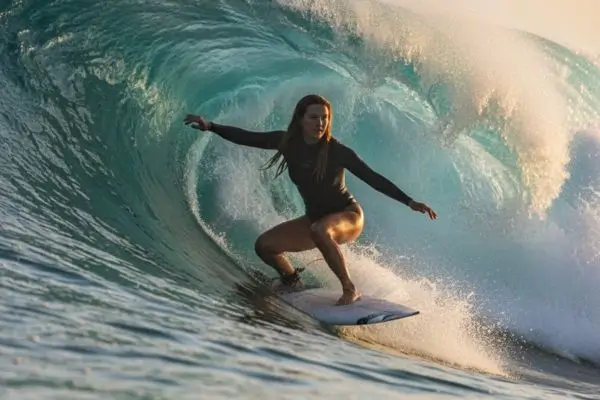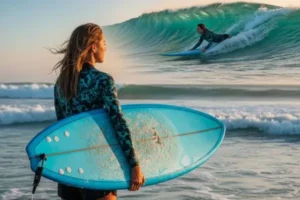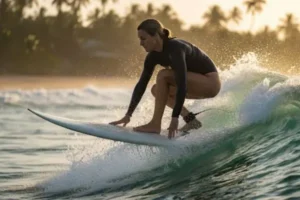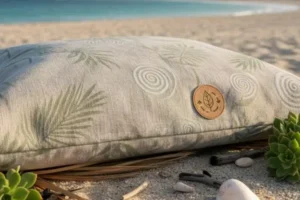There’s a moment in surfing when everything else fades away — when the sound of the ocean replaces thought, and movement feels effortless. That moment is called flow, and for many women who surf, it represents far more than technique. It’s a state of connection, awareness, and freedom that transforms how we move through both the water and life itself.
Learning to find flow isn’t just about catching better waves. It’s about developing presence — the ability to tune into the rhythm of the ocean, your body, and your emotions all at once.
Understanding the Concept of Flow in Surfing
In psychology, the term flow describes a state of complete immersion in an activity. Time seems to slow down, focus sharpens, and action feels spontaneous rather than forced. For surfers, this state often happens between paddling, standing, and gliding — when every movement feels natural, guided by intuition rather than thought.
Flow in surfing isn’t something you chase; it’s something you allow. It appears when preparation meets surrender — when technique and instinct work together.
For beginner women surfers, recognizing this state early on can change the entire learning experience. Instead of battling the waves, you start dancing with them.
The Role of Presence in Surfing
Presence is the foundation of flow. It’s the quiet awareness that anchors you in the here and now — not in the last wipeout or the next wave.
When you paddle out, distractions fall away: no phone, no noise, no rush. The ocean invites you to listen — to your breath, your heartbeat, and the subtle changes in current and wind. Every small detail becomes part of the dialogue between you and nature.
For many women, this awareness feels healing. The ocean becomes a space where perfection doesn’t matter — presence does. It’s about trusting the water, your balance, and your process.
Presence also transforms fear into curiosity. Instead of resisting waves, you begin to read them, learning their language one swell at a time.
Training the Mind for Flow
Flow isn’t just a physical experience — it’s a mental practice. Building mental clarity helps your body respond naturally when opportunities appear on the wave.
Here are a few ways to cultivate that focus:
- Breathe consciously before entering the water. Slow, rhythmic breathing calms the nervous system and prepares you for immersion.
- Set a small intention for each session. It could be as simple as “stay relaxed while paddling” or “enjoy every takeoff.”
- Let go of perfection. Flow begins when expectations dissolve. Focus on sensations, not performance.
- Embrace pauses. Resting between sets, watching the horizon, and feeling the sun on your skin also build awareness.
By practicing mindfulness both on and off the board, you train your brain to stay present even in challenging conditions.
Body Awareness and the Art of Movement
Surfing in flow means moving in harmony with the ocean, not against it. That requires body awareness — understanding how your center of gravity, breathing, and muscle engagement affect every motion.
Yoga, Pilates, and balance training can help develop this awareness. Many female surfers incorporate these practices into their routines to improve flexibility, stability, and mental calm.
During surfing, awareness extends to the smallest details: how your toes grip the board, how your hips rotate when turning, how your gaze leads the movement. These micro-adjustments create fluidity — the essence of flow.
When your body learns to respond instinctively, surfing becomes less about control and more about rhythm.
Embracing the Ocean’s Rhythm
The ocean teaches patience better than any coach. Some days, waves align perfectly. Others, they crumble before you can stand. Learning to flow with these changes — instead of resisting them — is one of surfing’s greatest lessons.
Tuning into the ocean’s rhythm means observing its mood. You learn to read its texture, anticipate its breath, and move when it calls. That synchronization brings serenity. You stop fighting time and start trusting timing.
In this space, surfing becomes meditation in motion — a conversation between human and water that requires no words.
For many women, this rhythm feels liberating. It dissolves self-doubt and invites self-acceptance. Each wave becomes an opportunity to reconnect with confidence and intuition.
Finding Flow Beyond the Waves
What happens in the ocean rarely stays there. The calm, focus, and trust built through surfing extend into daily life.
Women who cultivate flow often describe feeling more balanced, less reactive, and more connected to their surroundings. They learn to handle uncertainty — both in the water and beyond — with the same grace they use to navigate a shifting swell.
That’s why so many describe surfing as a teacher. It reminds us that balance isn’t static; it’s something we constantly adjust as life changes beneath our feet.
The same mindset that allows you to ride a wave can help you handle a difficult conversation, an unexpected change, or a creative challenge.
The Feminine Connection to Flow
There’s something deeply feminine about the concept of flow. It reflects intuition, adaptability, and emotional intelligence — qualities often overlooked in traditional surf culture.
As more women step into surfing, they bring with them a new approach to performance — one rooted in empathy, presence, and connection rather than competition. This shift is reshaping how surf communities around the world talk about success and self-expression.
Flow, in this sense, becomes a form of empowerment. It’s not just about mastering the ocean but about embracing your natural rhythm — the one that lets you move freely, think clearly, and feel fully alive.
Finding flow and presence in every wave isn’t about chasing perfect moments — it’s about learning to see beauty in imperfection. Each session, each fall, and each paddle builds awareness and resilience.
For women surfers, this journey represents more than sport. It’s a reminder that harmony doesn’t come from control but from connection — with your body, your breath, and the sea.
When you stop trying to dominate the waves and start moving with them, you don’t just surf better — you live better. The ocean becomes both a mirror and a guide, teaching you how to move gracefully through every tide of life.




